Today, I want to introduce stir-frying noodles with a deep cultural heritage of Indian Muslim origin in Malaysia – Mee Goreng Mamak.
Mee refers to noodles, and goreng means stir-frying in both the Malay language and Indonesian language.
Mee Goreng (also spelled as mi goreng) completely differs from Chinese noodles like Chow Mien, and the Malaysian Char Kuey Teow due to different ingredients and spices.
Fresh yellow noodles are the most popular choice, followed by dried instant noodles. You can use Chinese egg noodles or rice noodles, but it is not how to cook mee goreng traditionally.
Mee goreng has become synonymous with the Mamak shops and many Indian Muslim street vendors because every such eatery will serve these noodles dish without fail. It is a street food that all locals have tried before.
This recipe is based on how Indian Muslims cook in Malaysia. You will find other mee goreng recipes from different regions. They are all using the same terminology, which means fried noodles.
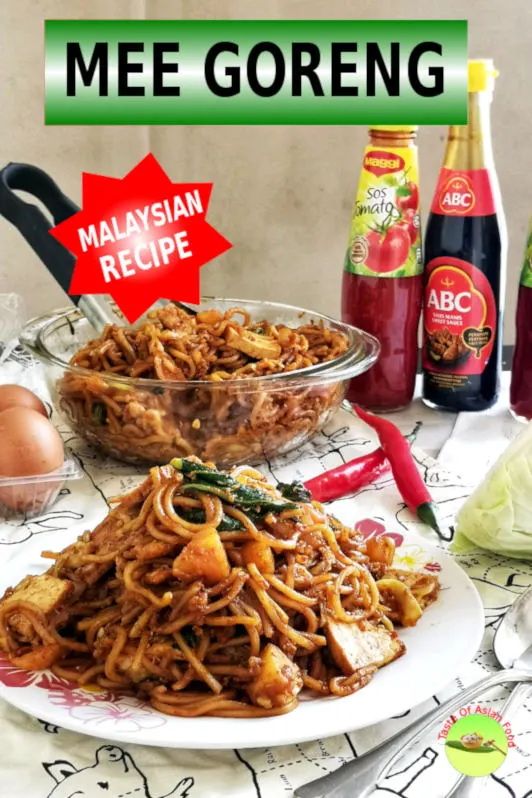
Note: This post may contain affiliate links. Please read my privacy policy for more info. I may receive commissions for purchases made through links in this post.
A. The characteristic of mee goreng Mamak in Malaysia
Let me highlight the uniqueness of these noodles. Tofu and potatoes are two indispensable ingredients for mee goreng. Ketchup is another must-have ingredient. These noodles are spicy, with chili sauce and sautéed chili paste called sambal.
The restaurant will cook it with curry and potatoes. Since we do not want to make a pot of curry merely for preparing the mee goreng, we will use curry powder in the recipe and boil some potatoes separately. You should be able to get the curry powder at most Asian grocery stores.
Here is the recipe for the easy Malaysian-style chicken curry with potatoes. Use it instead of the Malaysian curry powder and boiled potatoes to cook the mee goreng if you have cooked it.
Most restaurants serve it as a meatless dish, the standard way of serving mee goreng. However, you can switch it up by adding shrimp, squids, or meat to the recipe.
Note: Mee goreng is also spelled as mie goreng in some recipes.
B. Here is my step-by-step guide to preparing mee goreng Mamak
1. Blanch the noodles with hot water
The yellow noodles are best blanched in hot water for a few seconds until it loosens. Remove, drain, and set aside once the noodles no longer stick together. This type of fresh noodles is already cooked, so the blanching time is short. It is easier to fry mee that do not stick together. Fresh egg noodles can be used as a substitute.
2. Prepare the ingredients
There are a few essential ingredients in this mee goreng Mamak recipe:
- Cabbage is a necessary ingredient for various fried noodles in different countries. It works because its crunchiness contrasts sharply with the noodles’ soft texture. There is no exception for mee goreng. Cutting the cabbage into thin strips is best to shorten the cooking time.
- Firm tofu is another regular item for mee goreng Mamak. Always choose the firm one, as the soft tofu can break into small pieces during stir-frying. If you get the regular tofu, I suggest deep-fried (or pan-fried for the less oily version) until it firms up before adding it to the noodles.
- You can add other sources of protein to the mee. Shrimp, squids, and chicken meat are common. I add some chicken meat to this recipe, but please omit it for a vegetarian meal.
- Cucur udang (prawn fritters) is another popular ingredient for mee goreng Mamak. The cook will cut one or two prawn fritters into smaller pieces and fry them with the mee. Again, since we are not running a restaurant at home, we will omit it in this mee goreng recipe.
- Potato is another essential ingredient for mee Mamak. In the restaurant setting, the cook will take the potato from the pot of curry. We will simulate the same method by boiling some potato wedges in advance.
- Other options are to prepare some crispy shallots and then use them as the topping for the noodles. You can also include some sliced green onions (spring onions) to be added at the final cooking stage.
3. Prepare the sauce
There is a big difference between the seasonings used for mee goreng versus Chinese, Vietnamese, and Japanese noodles. Kecap Manis (sweet soy sauce) is the required ingredient. It has a unique flavor and cannot be substituted with other types of soy sauce. If you do not have it, you can substitute it with light soy sauce, dark soy sauce, and some sugar.
Ketchup (tomato sauce) should not be substituted with tomato paste or fresh tomato; it will taste more like bolognese.
Chili sauce is a must for the traditional recipe, but I understand that not everyone can take spicy food. Therefore, you have to adjust the level of spiciness yourself. The locals would prefer to make it even spicier by adding sambal oelek (the local sauteed chili paste) and chopped bird’s eye chilies to the mee goreng.
Other seasoning items are more common among different Asian cuisines. Oyster sauce is not the typical seasoning, but I include a small amount for extra flavor.
Once you measure all the seasoning ingredients in a bowl, add some water to dilute it so it is easier to pour into the wok while stir-frying. You can add each of the ingredients separately, but premixed seasoning can avoid any omission or double the amount accidentally as there are quite many items on the list.
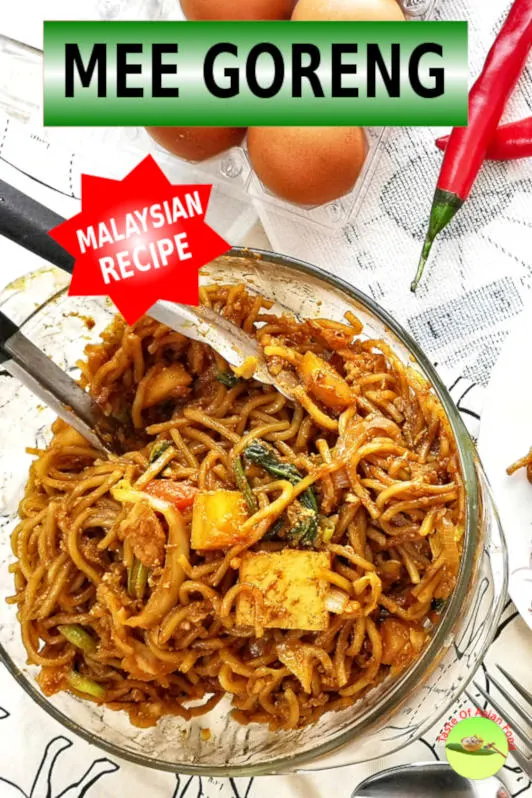
4. Tips before you start
Once you have prepared the sauce and all the ingredients, you can get it onto the dining table within five minutes. I like stir-fry because it’s the quickest method to cook anything.
- Get a good wok. The eggs tend to stick onto the surface, so use a well-seasoned large wok. You may also want to use a large non-stick pan or a large skillet as it does not require extremely high heat like other Chinese stir-fried dishes.
- Cut the stem of the choy sum into one cm section. Stir-fry with the cabbage strips for a minute or two before adding the leafy part of the choy sum. The stem takes longer to cook until it turns soft. If you don’t have the choy sum, substitute it with bok choy, but the taste will no longer be authentic.
- Indian Muslims can take hot food. Adding chili boh (local chili paste), sambal (sauté chili, garlic, and onion paste), and bird’ s-eye chili into the recipe is the norm. Since not everyone can withstand the spiciness of the original recipe, I have omitted all these items, with only the bottled chili sauce in the recipe. This bottled chili sauce is not fiercely hot and is essential to keep it close to the authentic flavor.
- Always add the egg last and scramble it into small pieces. The eggs should be nearly cooked before folding into the noodles. It will coat the noodles partially and combine with the sauce while cooking. I like the slightly wet mee goreng with eggs, called mee goreng basah in Malay. That’s truly the Malaysian style mee goreng you will expect at the local stores.
- Squeeze some fresh lime juice to the mee right before serving to add another flavor dimension. (Optional)
- The sequence of adding the ingredients is not critical, except the vegetables must be first, and the eggs are always last. The more crucial issue is to combine the sauce with the noodles evenly. Add some water if the sauce is too dry to blend well with the noodles. The outcome should be slightly wet, not as dry as most Chinese stir-fry noodles.
- The noodles and the eggs stick to the wok easily, especially over high heat. Use medium-high heat to stir-fry the noodles. The flavor is the result of the combination of seasonings and ingredients. Since it is not so dependent on high heat, the concept of wok-hei plays a secondary role in mee goreng Mamak.
Related recipes to this easy mee goreng recipe
If you like this mee goreng recipe, you most likely want to try other famous Malaysian/Indonesian noodles. Here are my picks:
- Soto ayam is a popular chicken soup dish that originated in Indonesia. It is a clear soup with many ingredients and condiments that no other chicken soup comes close to.
- Ipoh Hor Fun is a soup noodle prepared with an exotic broth, prepared with chicken bones and shrimp shells. Besides the broth, shredded chicken is the main ingredient. It is one of the most popular Malaysian Chinese soup noodles.
- Siam Road Char Kuey Teow of Penang has ranked 14th on the World Street Food Top 50 list at the World Street Food Congress 2017 in Manila. It is a noodle dish with Chinese sausage, cockles, pork crackling, and plenty of wok aroma.
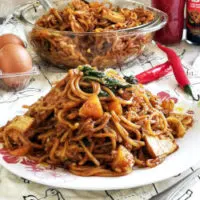
Mee Goreng
Today I want to introduce a stir-frying noodle with a deep cultural heritage of the Indian Muslim origin in Malaysia - Mee Goreng Mamak.
Mee refers to noodles, and goreng means stir-frying in both Malay and Indonesian language.
Ingredients
Sauce (A)
- 23g (1.5 tbsp) kicap manis (sweet soy sauce)
- 20g (4 tsp) dark soy sauce
- 10g (2 tsp) oyster sauce
- 60g (4 tbsp) ketchup
- 75g (5 tbsp) chili sauce
- 1/2 tsp ground white pepper
- 8g (1tbsp) Malaysian curry powder
- 30ml (2 tbsp) water
Others (B)
- 450g yellow noodles
- 3 tbsp cooking oil
- 3 cloves garlic, coarsely chopped
- 1 small onion (70g), thinly sliced
- 75g chicken breast meat, cut into thin slices
- 150g choy sum
- 100g cabbage, thinly sliced
- 150g firm tofu
- 1/2 tomato (50g), diced
- 1 small potato (70g), diced and boiled until soft
- Sambal and bird's eye chili (to adjust spiciness)
- 3 eggs
- 1/2 teaspoon salt
- One lime for juice and decoration
Instructions
- Blanch the mee in boiling water for fifteen seconds. Drain and set aside.
- Combine all the ingredients in (A).
- Heat some vegetable oil in the wok. Saute the onion and garlic until aromatic.
- Add the chicken bread meat and season with salt. Fry until it is cooked and slightly brown.
- Stir-fry the choy sum and cabbage with some oil and season with salt. Add some water if it is too dry.
- When the vegetables turn soft, return the chicken meat to the wok. Then add the tofu, tomatoes, slices of potatoes, and the sauce (A).
Add the yellow noodles combined with all the ingredients in the wok. - Add some water if it is too thick.
- Turn up the heat to medium/high, stir-fry for a minute.
- Reduce the heat to low. Then, push the noodles to one side of the wok. Add some more oil to the wok and crack the egg on it.
- Spread out the egg with the spatula and slowly fold into the noodles. It will be sticky, so continuous stirring and flipping are necessary.
- Remove and serve with lime wedges
Recommended Products
As an Amazon Associate and member of other affiliate programs, I earn from qualifying purchases.
Nutrition Information:
Yield: 3 Serving Size: 3 servingsAmount Per Serving: Calories: 877Total Fat: 37gSaturated Fat: 7gTrans Fat: 0gUnsaturated Fat: 24gCholesterol: 243mgSodium: 1890mgCarbohydrates: 94gFiber: 10gSugar: 21gProtein: 45g
This data was provided and calculated by Nutritionix on 8/12/2019

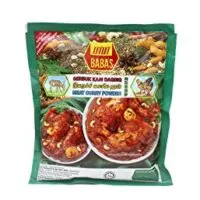

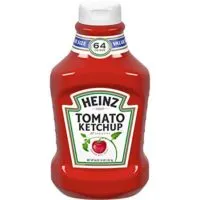
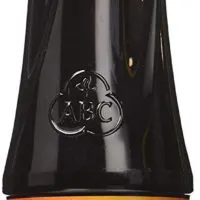
Sigh. But a Pleasant Sort of Sigh. The Good Kind. – neon nocturnal.
Wednesday 18th of June 2025
[…] last one that I actually consider a tie with the fish curry is a plate of mee goreng (fried noodles) that I had, also during a trip to Malaysia years ago. I had this at a food court […]
Beef Rendang Recipe (How to make authentic Indonesian Rendang)
Friday 13th of December 2024
[…] Mee Goreng is another great street food of Indian Muslim origin in Malaysia. It is authentically Malaysian and is the typical Indian Malaysian food. […]
Karman Foods
Friday 18th of February 2022
Tried this Mee Goreng recipe and it is indeed the best. Though I love the instant one, too - Indomie Mi Goreng Instant Fried Noodles BBQ Chicken Flavor is my fave. It's my new found fave food. Best paired with Vitasoy Lychee Flavor Vita Juice Drink.
Florence Lier
Sunday 17th of October 2021
Yummy and authentic mee Goreng. My husband, a western loved it too and have requested for more “heat”! Many thanks for sharing the recipe, Kwan.
KP Kwan
Monday 18th of October 2021
Glad to know you and your husband love it. More heat! :)
Aun Chea
Thursday 25th of March 2021
Delicious, thanks for the recipe! May I know what type of wok are u using in this video? Is it carbon steel or cast iron?
KP Kwan
Friday 26th of March 2021
It is a cast iron wok.